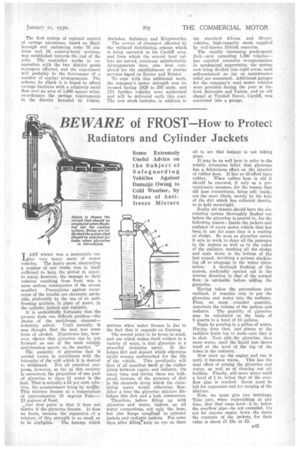BEWARE of FROST—How to Protect
Page 69

If you've noticed an error in this article please click here to report it so we can fix it.
Radiators and Cylinder Jackets
"VAST winter was a memorable one _Lifer Very many users of motor vehicles. The heavy snow, obstructing a number of our roads, was in itself sufficient to keep the period in mind ; to many, however, the damage to their vehicles resulting from frost was a more serious consequence of the severe weather_ Precautions against recurrence of the trouble are obviously advisable, preferably by the use of an antifreezing mixture, in place of water, in the cylinder jackets and radiator.
It is undoubtedly fortunate that the present finds one difficult problem—the choice of the anti-freeze element— definitely solved. Until recently, it was thought that the best was some form of alcohol. Experience has, however, shown that glycerine can be put forward as one of the most reliable anti-freezing agents on the market.
The quantity of glycerine that is needed varies in accordance with the intensity of the cold which it is desired
to withstand. For all practical purposes, however, so far as this country is concerned, the proportion of one part of glycerine to three of water is the best. That is actually, a 25 per cent. solution, the measurement being by weiiht. This mixture freezes at a temperature of approximately 19 degrees Fahr.— 13 degrees of frost.
Our first point is that it does not matter if ,the glycerine freezes. It does no harm, because the expansion of a mixture, of this strength is se small as to be negligible. The damage which accrues when water freezes is due to the fact that it expands on freezing.
The second point to be borne in mind, tied one which makes itself evident in a variety of ways, is that glycerine is a powerful cleansing agent. It dislodges dirt and deposit which otherwise might remain undisturbed for the life
of the vehicle. This peculiarity will first of all manifest 'efelf at the rubber joints between engine and radiator. On many vans and lorries these are letikproof, because of the presence of dirt in the channels along which the circulating water would otherwise flow. After a time the glycerine mixture dislodges this dirt and a leak commences.
Therefore, before filling up with glycerine and water, tighten up all water connections, not only the hose, but also flange couplings to cylinder jackets and radiator jackets. For some days after fillingr keep an eye on them all to see that leakage is not taking place.
It may be as well here to refer to the totally erroneous belief that glycerine has a deleterious effect on the interior of rubber hose. It has no ill-effect upon
rubber. When rubber hose is old it should be renewed, if only as a precautionary measure, for the reason that old hose connections, being soft' inside, are the more likely, merely by the help of the dirt which has collected therein, to be held watertight.
Really old chassis should have the circulating system thoroughly flushed out before the glycerine is poured in, for the following reason: Inside the jackets and radiator of every motor,velticle that has been in use for some time is a coating ofsludge. So soon as glycerine enters it sets to work to clean all the passages in the jackets as well as in the tubes of the radiator, washing all the sludge and scale down to the bottom of the last named, involving a. serious slackening off or stoppage in' the water circu
lation. A thorough flushing of the system, preferably carried out in the reverse direction to that of the normal Ilow,is-advisable before adding the glycerine.
Having taken the precautions just outlined, it remains only to put the glycerine_ and water into the radiator. First, we must consider quantity. Ascertain the volume of the jackets and radiator. The quantity of glycerine may be calculated on the basis of 9 quarts to a total of 10 gallons.
Begin by pouring in a gallon of water. ,Having done that, just glance at the radiator drain tap to make sure that it is shut. Next add ithe glycerine, then more water, until the liquid just shows itself at the level of the top of the tubes in the radiator.
Now start up the engine and run it until it becomes warm. This has the dual effect of mixing the glycerine and water, as well as of clearing out air bubbles. Finally, add more water until a level of 1 in. below_ that of the overflow pipe is reached. Room must be left for expansion and for surging of the mixture.
Now, we must give two warnings. Take care, when replenishing at any time, that that same Ievel-1 in. below the overflow pipe—be not exceeded. Do not let anyone empty down the drain the contents of the jackets, for their value is about 15s. or £2.




















































































































